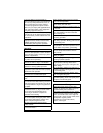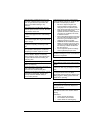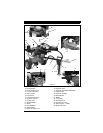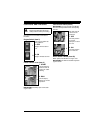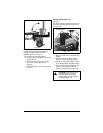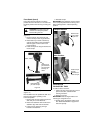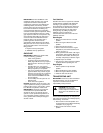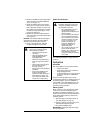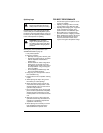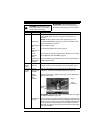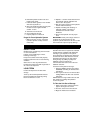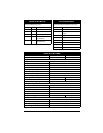
EN - 15
IMPORTANT: DO NOT OVERFILL! This
equipment and/or its engine may include
evaporative emissions control system
components, required to meet EPA and/or
CARB regulations, that will only function
properly when the fuel tank has been filled to
the recommended level. Overfilling may
cause permanent damage to evaporative
emissions control system components. Filling
to the recommended level ensures a vapor
gap required to allow for fuel expansion. Pay
close attention while filling the fuel tank to
ensure that the recommended fuel level
inside the tank is not exceeded. Use a
portable gasoline container with an
appropriately sized dispensing spout when
filling the tank. Do not use a funnel or other
device that obstructs the view of the tank
filling process.
4. Replace fuel cap and tighten.
5. ALWAYS clean up spilled fuel.
GASOLINE
IMPORTANT: ALWAYS use gasoline that
meets the following guidelines:
• Clean, fresh gasoline.
• A minimum of 87 octane/87 AKI (91
RON). High altitude use may require a
different octane. Consult your engine
manual.
• Gasoline with up to 10% ethanol
(gasohol) or up to 15% MTBE (methyl
tertiary butyl ether) is acceptable.
• Use of any gasoline other than those
approved above may void the engine
warranty. If the pumps are not marked
for the content of alcohol or ethers,
check ethanol and MTBE levels with
the fuel supplier.
• Do not modify the fuel system to use
different fuels.
• Never mix oil and gasoline.
NOTICE: All gasoline is not the same. If the
engine experiences starting or performance
problems after using a new gasoline, switch
to a different fuel provider or fuel brand.
IMPORTANT: Excessively oxygenated or
reformulated fuels (fuels blended with
alcohols or ethers) can damage the fuel
system or cause performance problems. If
any undesirable operating problems occur,
use a gasoline with a lower percentage of
alcohol or ether.
Fuel Stabilizer
Gasoline left in the fuel system for extended
periods without a stabilizer will deteriorate,
resulting in gum deposits in the system.
These deposits can damage the carburetor
and the fuel hoses, filter and tank. Prevent
deposits from forming in the fuel system
during storage by adding a quality fuel
stabilizer to the fuel. Follow the
recommended mix ratio found on the fuel
stabilizer container.
Start Engine
1. Make sure control lever is in neutral
position.
2. Move the engine switch to the ON
position.
3. Open the fuel shut off valve.
4. Set the choke lever based on engine
temperature
(see Choke Control Lever
(Item 3) on page 11).
5. Slowly pull the recoil starter until engine
compression makes pulling difficult. Let
the starter rewind a little, and then pull
smoothly and quickly to start the engine.
6. Repeat step 5 as needed.
7. Fully open the choke and set the throttle
to full fast before operating the unit.
Stop Engine
1. Return cylinder to fully retracted
position.
2. Move throttle lever to slow position.
3. Move the engine switch to the OFF.
4. Close the fuel shut-off valve.
TRANSPORTING UNIT
IMPORTANT: Check local, state and federal
laws before towing unit. Any modifications
required to meet these laws are the
responsibility of the purchaser.
Ensure that wheel bearings are well packed
with grease and that tires are inflated properly
before towing. To tow unit:
1. Place beam in horizontal position and
engage beam lock
(see Beam Assembly
Lock (Item 14) on page 12).
2. Move fuel shut-off valve to closed
position.
CAUTION: Unit can cause
serious injury if it rolls out of
control or tips over. Chock wheels
when unit is not attached to a tow
vehicle.



